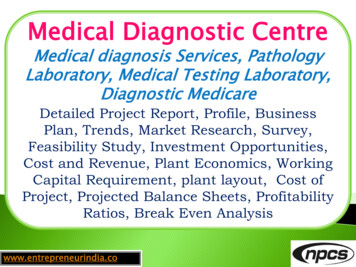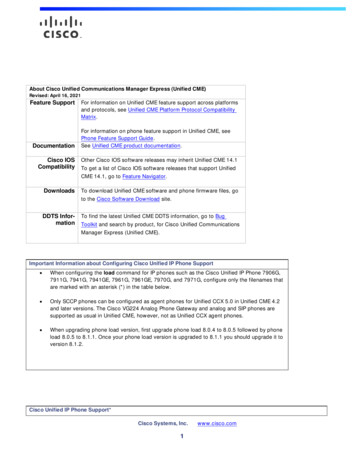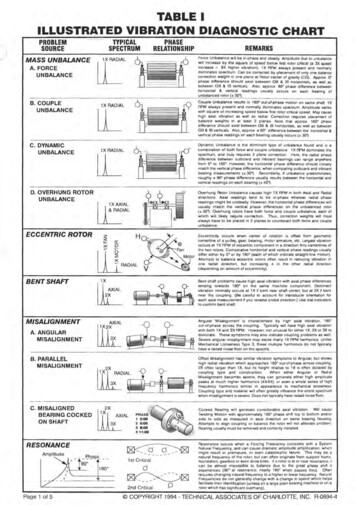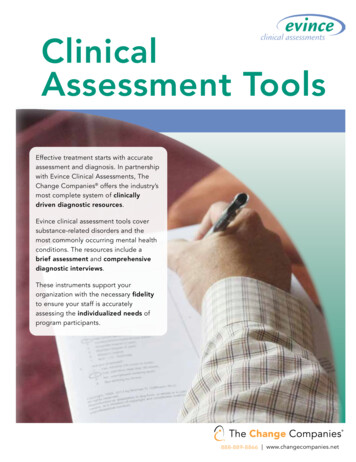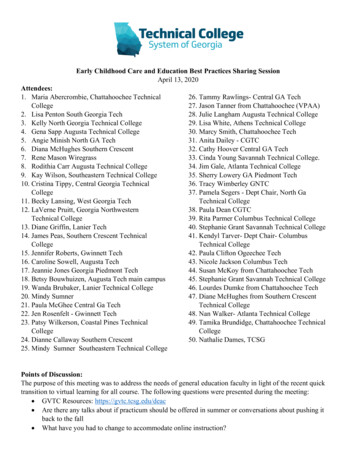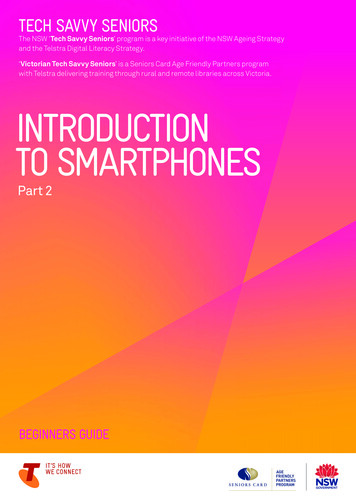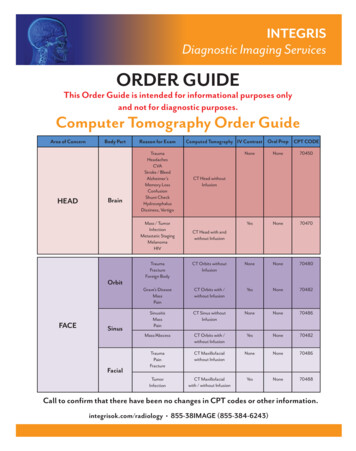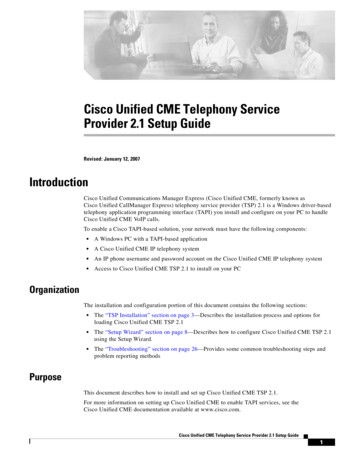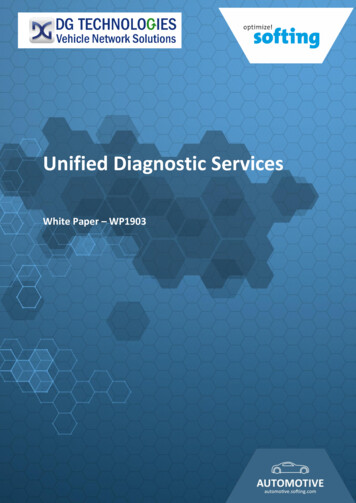
Transcription
Unified Diagnostic ServicesWhite Paper – WP1903Unified Diagnoistic Services
White PaperUnified Diagnostic ServicesCONTACTSofting Automotive Electronics GmbHRichard-Reitzner-Allee 685540 Haar – GermanyE-mail: info.automotive @ softing.comInternet: www.automotive.softing.comExclusion of LiabilityThe information provided in this White Paper corresponds to the state of art whengoing to press and is provided to the best of our knowledge. We will not accept anywarranty claims arising from the information provided in this paper, especiallywarranties for quality and durability pursuant to section 443 of the German CivilCode. We reserve the right to make improvements and additions to and to includenew findings in this White Paper without giving advanced notice.Errors and omissions reserved. We provide this White Paper to our customerss andprospective clients free of charge.Reprinting and reproducing this White Paper and making it available electronically,even in the form of excerpts, is only permissible with our written consent.All rights reserved.Legal NoticeSofting Automotive Electronics GmbHManaging Directors: Armin Baumann, Oliver Fieth, Dr. Wolfgang TrierTable of Contents1.What is diagnostic communication? . 22.Diagnostic communication in the OSI Model . 33.OSI Model Application Layer Services and SIDs . 34.Data Parameters and Sub-function Bytes . 45.Negative Responses and NRCs . 56.UDS on CAN DoCAN . 57.UDS on IP DoIP . 68.TST Technology . 6Referenceshttp://profiles.sae.org/79697328210/ Softing Automotive - White Paper 1903Page 1
White PaperUnified Diagnostic Services1. What is diagnostic communication?Diagnostic communication is communication between a vehicle or mobile machine andexternal test equipment (tester). Actually, the communication does not take place betweenthe tester and the vehicle or machine, but at a certain point in time, between the tester andone specifically selected electronic control unit (ECU).Figure WP1303-01: Diagnostic service requests and responsesFor the purpose of diagnostic communication, the tester (TST) sends a diagnostic servicerequest to the ECU and receives the diagnostic service response from the ECU (FigureWP1303-01).Figure WP1903-02: Components of a diagnostic communication System Softing Automotive - White Paper 1903Page 2
White PaperUnified Diagnostic ServicesTo do so, tester (TST) and vehicle (ECU) must be connected to each other by a VehicleCommunication Interface (VCI). Figure WP1303-02 shows the components of a genericdiagnostic communication system.2. Diagnostic communication in the OSI ModelThe OSI Model structures data communication systems in seven layers. In the context of thisWhite Paper, “UDS” is an OSI Model application layer protocol. “CAN” is specified as OSImodel physical and data link layer protocols. The concatenations “UDS on CAN” and “UDS onIP” are diagnostic protocol stacks that consist of several, independently specified OSI modellayers. Other examples are “KWP on K-Line” or “OBD on CAN”. Figure WP1903-03 showshow the diagnostic communication protocol stacks “UDS on CAN” and “UDS on IP” aremapped to the OSI Model.Figure WP1903-03: UDS on CAN and UDS on IP protocol stacks3. OSI Model Application Layer Services and SIDsTable WP1903-01 lists the 27 Unified Diagnostic Service (UDS) requests as they are specifiedin ISO 14229-1 (2018). Each service request comes with a uniquely assigned service identifier(SID), such as 0x10 diagnostic session control request, 0x22 read data by identifierrequest or 0x3E tester present request. Each request has an assigned positive response,whereas the SID of a response can be calculated by adding 0x40 to the SID of the request.Table WP1903-02 shows examples. The SID of a negative response is always 0x7F. Softing Automotive - White Paper 1903Page 3
White PaperUnified Diagnostic ServicesTable WP1903-01: Services and Request SIDs according to ISO 14229-1 (2018)Table WP1903-02: Examples of request and response SIDsRequest SIDServicePos. ResponseSID0x10Diagnostic session control0x500x22Read data by identifier0x620x31Routine control0x710x85Control DTC settings0xC54. Data Parameters and Sub-function BytesUDS requests and responses can be parameterized by sub-function bytes and/or dataparameters. Data parameters are identified by Data Identifier (DID). Table 1903-03 showssome selected DID examples. Softing Automotive - White Paper 1903Page 4
White PaperUnified Diagnostic ServicesTable 1903-03: Examples of Data Identifier (DID) - ExamplesDIDDescription0xF180Boot software identification0xF18CECU serial number0xF190Vehicle Identification Number (VIN)5. Negative Responses and NRCsIf an ECU is not able to support a request, for example if it cannot deliver the requested data(0x22 read data by identifier) or cannot process a requested action (0x11 ECU reset) – forwhat reason ever – the ECU will send a negative response with the negative response SID0x7F.The negative response consists of three bytes: The first byte is the SID of the negativeresponse (0x7F), the second one is the SID of the denied request. The third byte is aparameter named negative response code (NRC). The NRC contains information, why theECU is not sending a positive response. Typical values of NRCs are listed in Table WP1903-04.Table 1903-04: Negative Response Codes (NRC) - ExamplesNRCComment0x10General reject0x11Service not supported0x12Sub-function not supported0x22Conditions not correct6. UDS on CAN DoCANCAN is specified in ISO 11898 and not part of this White Paper.DoCAN is short for “Diagnostics on CAN” and specified in ISO 15765. It describes, how ISO14229 services are transferred using the physical and data link layers of CAN.A specific “problem” of CAN is the limited number of data bytes that fit in a single CAN frame.The Vehicle Identification Number, for example, consists of 17 bytes and does not fit in asingle CAN message frame.The request to read the VIN reads0x[22,F1,90].The positive response could 32,36,32,32,35], whereas the 17 data bytes Softing Automotive - White Paper 1903Page 5
White PaperUnified Diagnostic Servicesafter the 0x [62,F1,90.] represent the VIN of a Harley Davidson motorcycle type FXWG MY1981.Data blocks that do not fit in a single CAN frame must be segmented and sent with several,consecutive CAN frames. The description of how that works is colloquially named ISO TP,whereas TP is short for transport protocol. ISO TP for UDS on CAN is specified in ISO 15765-2.7. UDS on IP DoIPEthernet is specified in IEEE 802.3 and not part of this White Paper.DoIP is specified in ISO 13400 and describes, how ISO 14229 services are transferred usingthe Internet Protocol IP and IEEE 802 Ethernet.8. TST TechnologyFigure 1903-04 shows the software components of a diagnostic tester. ODX is short for theOpen Diagnostic Data Exchange format and OTX for the Open Test Sequence exchangeformat.The Smart Diagnostic Engine (SDE) processes service requests and responses using the ODXdata that mainly contains the specification of the diagnostic communication protocol stackand computational methods to translate hex coded diagnostic data into meaningfulinformation. The OTX data base contains scripts that describe diagnostic sequences, e.g. forguided fault finding or flash reprogramming of a control unit. Softing Automotive - White Paper 1903Page 6
White PaperUnified Diagnostic ServicesFigure WP1903-04: Software components of a diagnostic testerThe application can be software on a WIN-based PC or an APP on an Android-/iOS- basedsmart device.The VCI and its firmware are connected to the SDE via one of the interfaces D-PDU API,RP1210 or SAE J2534, whereby a VCI is not necessary anymore if a regular PC with a RJ45Ethernet port and UDS on IP are employed.Amendment LogVersion01Date2019-06-23AuthorSubkeDescription / Comment / books/content/r-474/ Softing Automotive - White Paper 1903Page 7
data that mainly contains the specification of the diagnostic communication protocol stack and computational methods to translate hex coded diagnostic data into meaningful information. The OTX data base contains scripts that describe diagnostic sequences, e.g. for guide

